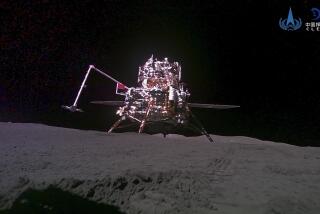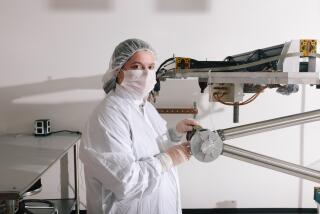Evidence suggests water exists on the moon
- Share via
Space scientists have found the strongest evidence yet that water exists on the moon, a discovery that helps complete a picture of a water-rich solar system and that could make colonizing our nearest neighbor in space much easier than previously thought.
Using data from three spacecraft that have made close flybys of the moon in recent years, research teams in the United States say they have found proof that a thin film of water coats the surface of the soil in at least some places on the moon.
“Within the context of lunar science, this is a major discovery,” said Paul G. Lucey, a planetary scientist with the University of Hawaii, who was not involved in the current research. “There was zero accepted evidence that there was any water at the lunar surface, [but] now it is shown to be easily detectable, though by extremely sensitive methods. As a lunar scientist, when I read about this I was completely blown away.”
The discovery “will forever change how we look at the moon,” added Roger Clark, a scientist with the U.S. Geological Survey in Denver and the author of one of three papers -- each dealing with data from a different spacecraft -- appearing in this week’s edition of Science magazine.
For decades, the moon had been considered a dead and uninteresting world by scientists. The Apollo missions of the 1960s and ‘70s brought back some rocks that contained tiny amounts of trapped water, but scientists at the time decided they had been contaminated by water from Earth.
Proponents of human space travel hope this discovery could put pressure on the White House to follow through with the George W. Bush administration’s plans to return to the moon by 2020 and to construct Earth’s first off-world colony there.
At the very least, the discovery lends weight to a new view of a friendlier solar system, where water, the lifeblood of biology on Earth, suddenly seems to be everywhere. Last year’s Phoenix mission to Mars’ polar region found ice just beneath the lander’s struts. Ice has been found on Saturn’s moon Titan and it covers Jupiter’s moon Europa.
Research teams from Brown University, the University of Maryland and the U.S. Geological Survey used spectroscopic measurements taken of the lunar surface by NASA’s Cassini and Deep Impact spacecraft, as well as India’s Chandrayaan 1 satellite. The instruments on all three spacecraft detected the signature of the OH chemical bond (oxygen and hydrogen) at many places on the lunar surface, including areas subject to daytime temperatures that reach the boiling point of water. The greatest concentrations, however, were found in the coldest regions near the two poles.
Detecting the OH bond is not a sure indicator of water. The instruments could be picking up hydroxyl, which is composed of one oxygen and one hydrogen atom. Water has two hydrogen atoms and one oxygen.
But one of the papers, by research scientists Lori Feaga and Jessica Sunshine of the University of Maryland, found clear evidence for both hydroxyl and water in measurements taken by the Deep Impact spectrometer on June 2 and June 9. “We saw both species,” Feaga said.
The amount of water in any one place is tiny. Clark estimated it at about a quart per ton of soil.
The moon “is almost as wet as a bone,” Lucey said in an e-mail interview with The Times. “It is in the form of an imperceptible film on soil grains, perhaps several molecules thick.”
Unless science makes some technological breakthrough, it would be extremely difficult for future moon colonists to harvest such tiny amounts of water. The research indicates, however, that the water migrates toward the poles -- by literally lifting off the soil particles and drifting north and south -- when the temperature rises during the lunar day.
When the water molecules land in a colder area near the poles, they are trapped there in higher concentrations, “perhaps high enough to use,” Lucey said.
The question of how much water might have accumulated at the poles could be answered on Oct. 9, when NASA’s Lunar Crater Observation and Sensing Satellite, known as LCROSS, is set to steer a rocket into a south pole crater called Cabeus A.
The resulting collision, which will send up a dust cloud two miles above the surface of the moon, will be observed and sampled by satellites and observatories on Earth for evidence of water. Cabeus A was chosen because it is in a perpetual shadow, so any water stored there in the form of ice would not melt.
“The results of the present studies lend credence to the lunar polar water hypothesis by providing a proven source of water on the surface of the moon,” Lucey said.
If there is water on the moon, where did it come from? One possibility, according to the research teams, is that the water was deposited by one or more comets colliding with the moon. Another is that meteorites colliding with the moon might have unearthed underground sources of water.
Finally, the solar wind, a stream of charged particles flowing outward from the sun, which is mostly made up of hydrogen and helium, could play a role. The solar wind could supply hydrogen to bind with oxygen in lunar soils.
Perhaps ironically, given how many spacecraft have orbited and landed on the moon in the last five decades, two of the spacecraft that made the discovery had other missions besides observing the moon. Cassini’s primary mission was to observe Saturn and its major moons, including the bizarre, smog-choked Titan. The measurements of the Earth’s moon were taken in 1999 as Cassini was on its way to Saturn.
Deep Impact shot a rocket into the comet Tempel 1 in 2005 to find out what a comet is made of, but has since been given other jobs, including rendezvousing with another comet. Chandrayaan 1, India’s first moon-orbiting satellite, was launched in October 2008.
All three spacecraft carried spectrometers, which operate by breaking down the light reflected off the surface of the moon. Because every chemical molecule has a different light wavelength signature, scientists analyzing the spectrograph can tell what the surface is made of. The reason the Deep Impact instrument was able to see both water and hydroxyl, Feaga said, was because it has a larger bandwidth than the instruments carried by Cassini and Chandrayaan.
“It is astounding to find water at all latitudes on the moon and in places where the temperature is hotter than boiling water on Earth,” Clark said.
The discovery comes at a pivotal time for America’s space program. Former President Bush set NASA on an ambitious course to return to the moon by 2020, and then travel on to Mars. But a presidential commission recently found that without a significant increase in its budget, NASA won’t be able to reach either goal.
It’s unclear how this discovery will affect the debate in Washington over NASA’s future, but the presence of water on the moon would presumably make colonization much easier. Water would not only be valuable for drinking, but it could also be used to make oxygen for breathing and to make rocket fuel for trips to and from Earth.
“Perhaps the most valuable result of these new observations is that they prompt a critical reexamination of the notion that the moon is dry,” Lucey said. “It is not.”
--






